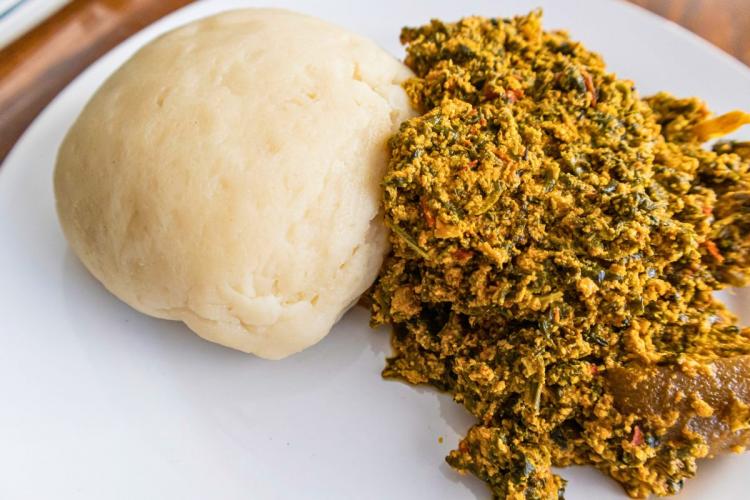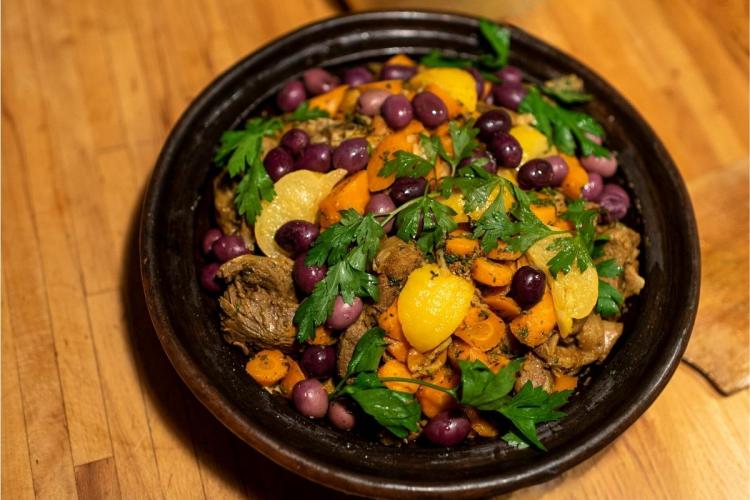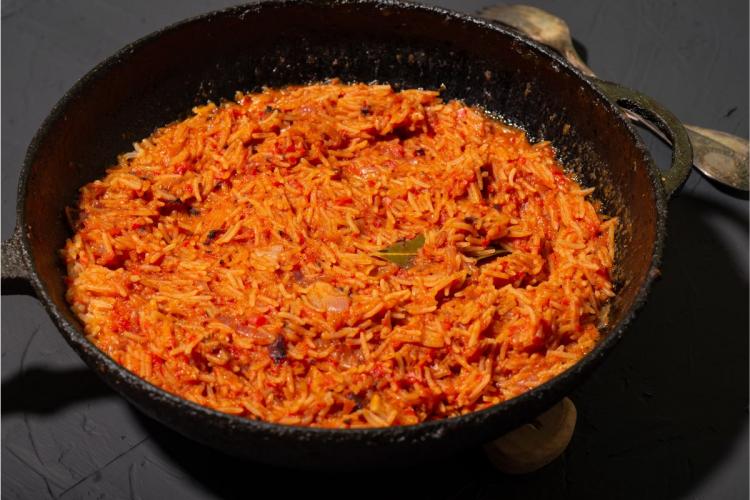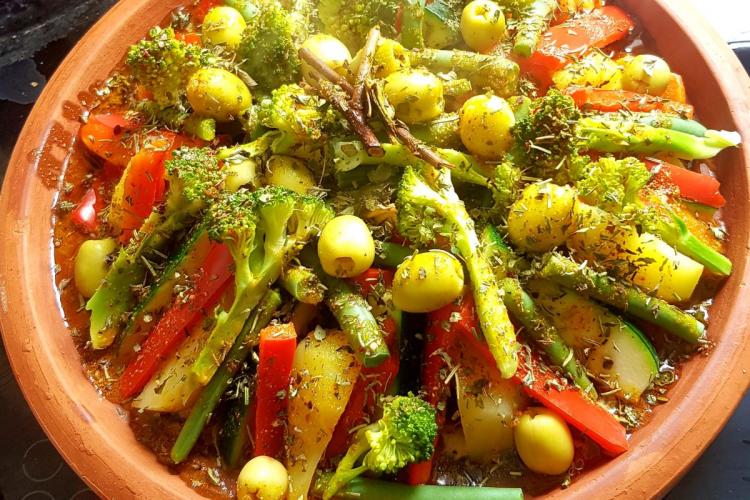Delicious African stews
A taste of the continent's culinary variety!
Get ready for a culinary adventure as we explore the rich and diverse flavors of African stews! From the spicy heat of West African peanut stew to the fragrant aromas of North African tagines, these dishes showcase the incredible variety of ingredients and techniques found across the continent. Embark on this exciting journey with us as we discover the mouthwatering delights that await in these amazing African stew recipes!
Extra flavor
- Experience the tantalizing flavors of African stews featuring unique spices, legumes, vegetables & proteins!
- Delight in West African peanut stew and Nigerian Egusi soup or try East African favorites like doro wat & githeri.
- Enjoy vegan options like jollof rice, misir wat & vegetable tagine for a mouthwatering culinary experience!
African stew essentials, ingredients and techniques
African stews are a celebration of flavors and textures, often combining an array of spices, legumes, vegetables, and protein sources to create a delicious and exciting dining experience. Baked beans, for instance, can add a delightful twist to some stews, while the use of fresh ingredients such as bell peppers, olive oil, and tomatoes ensures that each dish is as vibrant and nutritious as it is tasty.
We’ll explore the key components of African stews, including the unforgettable spices, legumes, vegetables, and proteins.
Spices and flavorings
African stews are renowned for their bold, aromatic flavors, thanks to the generous use of spices and flavorings. Some key spices used in African cuisine include:
- Berbere spice: a key ingredient in Ethiopian dishes, lends a complex heat to recipes such as doro wat.
- Suya spice: a Nigerian spice blend that adds a deliciously smoky taste to dishes.
- Ras el hanout: a famous Moroccan spice blend that adds depth and warmth to tagines and other North African dishes.
These spices contribute to the unique and flavorful taste of African stews.
Given the rich variety of spices available, African stews indeed provide a sensory feast.
Legumes and vegetables
Legumes and fresh vegetables form the backbone of many African stews, providing not only nutrition but also color and texture. Some popular examples include:
- Sweet potatoes in West African dishes
- Black-eyed peas in West African dishes
- Okra in East African cuisine
- Collard greens in East African cuisine
From the nutty flavor of chickpeas in Tunisian lablabi to the soft, creamy texture of cannellini beans in South African chakalaka, legumes and vegetables are essential ingredients that make each stew a unique and satisfying culinary experience.
Proteins and meat alternatives
African stews often feature a variety of proteins, such as chicken, beef, and fish, which add both flavor and substance to these hearty dishes. But for those seeking plant-based alternatives, options abound! Lentils, quinoa, tofu, and seitan can easily be incorporated into traditional recipes, creating delicious vegan variations that are just as satisfying as their meat-based counterparts.
Whether it’s the tender chicken in Ethiopian doro wat or the succulent beef in Tanzanian ndizi nyama, proteins significantly contribute to the satisfying nature of African stews.
West African stew delights
West African stews are a delicious showcase of the region’s culinary prowess, featuring dishes that are both hearty and packed with flavor. Peanut stew, Nigerian egusi soup, and Senegalese maafe are just a few examples of the irresistible stews that await in this vibrant part of Africa. Each dish is a celebration of local ingredients and culinary techniques, creating a mouthwatering medley of tastes that will have you coming back for seconds!
Peanut stew
West African peanut stew is a delectable dish that combines the creamy richness of peanuts with the bright flavors of tomatoes and vegetables. To make this delightful stew, follow these steps:
- Sauté garlic and ginger in olive oil.
- Add sweet potatoes, chicken (optional), onions, tomato sauce or diced tomatoes, and peanut butter.
- Simmer until the vegetables are tender and the flavors meld together, creating a luscious, satisfying meal.
For an extra burst of flavor, consider adding carrots, roasted bell peppers, or even experimenting with different types of legumes like baked beans. This versatile stew is a surefire hit at any dinner table and can easily become a staple dish!
Nigerian egusi soup
Nigerian egusi soup is a thick, hearty stew made with ground melon seeds, vegetables, and meat or fish. The unique texture of the melon seeds creates a rich, satisfying base for the stew, which is then flavored with a blend of spices, including palm oil, onions, tomatoes, and African crayfish.
To prepare this scrumptious dish, follow these steps:
- Begin by frying the ground melon seeds in palm oil.
- Add vegetables and meat or fish.
- Simmer until the ingredients are cooked through.
- Enjoy the deliciously creamy stew.
For an interesting twist on this Nigerian classic, try adding spinach or okra to your fried plantains, or explore different meat and fish options such as beef, chicken, or shrimp.
Senegalese maafe
Senegalese maafe is a sumptuous stew that combines the rich flavors of meat, vegetables, and a luscious peanut sauce. To make this delectable dish, follow these steps:
- Brown the beef or chicken in a large pot.
- Add onion, garlic, ginger, bell peppers, and tomato paste. Cook for a few minutes.
- Stir in the peanut butter and tomatoes.
- Simmer for about 30 minutes, stirring occasionally, until the flavors blend together and the sauce reaches your desired consistency.
Enjoy the delicious flavors of Senegalese maafe!
Serve with cooked rice or couscous, and savor the delightful combination of flavors that makes Senegalese maafe a true culinary gem.
East African stew favorites
East African stews offer a fascinating array of flavors, from the fiery heat of Ethiopian doro wat to the comforting simplicity of Kenyan githeri and the exotic taste of Tanzanian ndizi nyama. These dishes showcase the region’s diverse ingredients and techniques, creating a tantalizing selection of stews that will leave your taste buds craving more!
Ethiopian doro wat
Ethiopian doro wat is a spicy chicken stew that is sure to set your taste buds ablaze! Made with:
- berbere spice
- onions
- garlic
- ginger
- tomatoes
This fiery dish, often considered a national dish, is served with injera bread, a spongy flatbread made from teff flour, which is perfect for scooping up every last morsel of the delicious sauce.
To make doro wat, sauté onions and garlic in oil, then add chicken and spices, simmering until the chicken is cooked through. For an authentic Ethiopian experience, serve the stew with injera bread, or try it with rice or couscous for a delightful twist.
Kenyan githeri
Kenyan githeri is a traditional stew made with maize, beans, and vegetables, offering a wholesome and satisfying meal packed with flavor. To prepare githeri, follow these steps:
- Begin by sautéing onions and garlic in oil.
- Add beans, corn, and spices to the pot.
- Cook until the ingredients are tender and the flavors meld together.
Enjoy your delicious githeri stew!
Githeri is typically served with chapati or rice, making it a versatile and filling dish that can be enjoyed as a main course or side dish. So grab your spoon and dig into this delicious Kenyan classic!
Tanzanian ndizi nyama
Tanzanian ndizi nyama is a tantalizing stew made with meat, plantains, and coconut milk, creating a dish that is both savory and slightly sweet. To make ndizi nyama, brown beef or chicken in a pot, then add plantains, garlic, cumin, salt, and pepper, cooking until the plantains are tender.
Finish by adding coconut milk and simmering until the desired consistency is achieved. Ndizi nyama is typically served with rice or ugali, a starchy side made from maize, making it a satisfying and flavorful meal that is sure to delight your taste buds.
North African stew inspirations
North African stews offer a captivating blend of flavors, with dishes like Moroccan tagine, Tunisian lablabi, and Algerian chorba showcasing the region’s unique culinary traditions. Each of these stews highlights the use of fragrant spices and fresh ingredients, making them a delicious and aromatic addition to any meal.
Let’s embark on a journey to explore these alluring North African delights.
Moroccan tagine
A Moroccan tagine is a slow-cooked stew that features meat, vegetables, and a medley of spices such as cumin, coriander, ginger, turmeric, and cinnamon. Traditionally cooked in a clay pot over low heat, this dish is a symphony of flavors and textures, creating a mouthwatering meal that is sure to impress.
To ensure your tagine is cooked to perfection, use long-grain rice and adjust the seasoning to your taste. Serve your tagine with couscous, bread, or rice for a truly unforgettable North African feast.
Tunisian lablabi
Tunisian lablabi is a flavorsome chickpea stew that combines:
- Rustic bread
- Extra virgin olive oil
- Yellow onion
- Garlic cloves
- Cumin seeds
- Coriander seeds
- Chili peppers
for a taste sensation that will have you coming back for more.
To prepare this scrumptious stew, sauté the onion and garlic in olive oil, then add the spices, sweet potato, and chickpeas, simmering until the chickpeas are cooked through.
Serve lablabi with crusty bread and a dollop of harissa for an authentic Tunisian experience that will transport your taste buds to the shores of North Africa.
Algerian chorba
Algerian chorba is a robust soup made with beef, tomatoes, and a variety of spices, often enjoyed during the month of Ramadan. This hearty dish is the perfect comfort food, with the rich flavors of the beef and tomatoes melding together in a tantalizing blend that will warm your soul.
To prepare chorba, follow these steps:
- Brown the beef in a pot.
- Add scallions, garlic, cilantro, celery, tomato paste, chickpeas, paprika, and spices.
- Simmer until the beef is cooked through.
- Enjoy this delicious North African stew with friends and family.
South African stew traditions
South African stews are a vibrant reflection of the country’s diverse culinary heritage, featuring dishes like Cape Malay curry, potjiekos, and chakalaka. These stews are a testament to South Africa’s rich history, with flavors and techniques that have been influenced by European, Indian, and indigenous African cuisines.
Let’s uncover these delightful South African stew traditions together.
Cape Malay curry
Cape Malay curry is a fragrant and flavorful South African stew made with meat, vegetables, and a blend of spices, often served with rice. This dish is a testament to the Cape Malay community’s culinary influence, with its unique combination of spices and flavors.
To make Cape Malay curry, follow these steps:
- Sauté onions, garlic, and spices in oil.
- Add meat and vegetables.
- Cook until the ingredients are tender and the flavors meld together.
- Serve with rice or other grains for a delicious and satisfying meal that is sure to impress.
Potjiekos
Potjiekos is a traditional South African stew cooked in a cast-iron pot over an open fire, made with meat, vegetables, and a variety of spices. To create this mouthwatering dish, layer the ingredients in the pot, beginning with the meat and vegetables, then adding the spices and stock. Cook over an open fire for several hours, stirring occasionally, until the flavors meld together and the ingredients are tender.
Serve hot with rice, bread, or other grains for a truly South African culinary experience.
Chakalaka
Chakalaka is a South African vegetable and bean relish, originating from the townships of Johannesburg, where goldmine workers would combine canned beans, tomatoes, and spices to create a flavorful and versatile dish. Today, chakalaka is enjoyed as a side dish or accompaniment to grilled meats, toast, or crackers, and can even be used as a condiment for sandwiches.
To make chakalaka, follow these steps:
- Sauté onions, green pepper, cabbage, green chili, carrots, and curry powder in oil.
- Add canned beans and simmer until the vegetables are cooked.
- Enjoy this delicious South African favorite with friends and family!
Vegan African stew options
For those seeking plant-based African cuisine, fear not! There are plenty of vegan stew options to explore, such as vegan jollof rice, Ethiopian lentil stew (misir wat), and vegetable tagine. These dishes showcase the rich flavors and textures of African cuisine while adhering to a plant-based diet.
Regardless if you’re a committed vegan or just eager to try something new, these vegan African stew options will undoubtedly satisfy your palate.
Vegan jollof rice
Vegan jollof rice is a mouthwatering West African dish that combines the classic flavors of jollof rice with the addition of vegetables and spices. To make this delicious vegan dish, follow these steps:
- Sauté onions, peppers, ginger, and garlic in vegetable oil.
- Add tomatoes and cook until they are soft.
- Finally, add the rice and cook until it is tender.
Serve your vegan jollof rice with a side of baked beans, green beans, or a fresh salad for a satisfying and flavorful meal that both vegans and non-vegans will enjoy.
Ethiopian lentil stew (misir wat)
Ethiopian lentil stew, or misir wat, is a spicy and flavorful vegan stew made with red lentils, berbere spice, and an array of vegetables. To create this delectable dish, follow these steps:
- Sauté onions and garlic in olive oil.
- Add red lentils, tomatoes, and spices.
- Simmer until the lentils are cooked through.
- Serve with injera bread or your choice of grain for a satisfying and protein-packed meal.
With its rich flavors and heartiness, Ethiopian lentil stew is sure to become a vegan favorite.
Vegetable tagine
A vegetable tagine is a vegan twist on the traditional Moroccan tagine, featuring a medley of vegetables and spices cooked to perfection. This succulent dish is made by sautéing vegetables and spices in oil, then adding water and simmering until the vegetables are tender.
Serve your vegetable tagine with couscous, rice, quinoa, or other grains for a filling and scrumptious vegan meal that will transport your taste buds to the heart of North Africa.
African comfort food
Food in Africa is very varied and African stews offer an incredible array of flavors, textures, and ingredients that celebrate the continent’s diverse culinary heritage. From the fiery heat of West African peanut stew to the fragrant aromas of North African tagines and the hearty comfort of South African chakalaka, these dishes showcase the very best of African cuisine. So why not embark on a culinary adventure and explore the delicious world of African stews? Bon appétit!
What is the most popular African stew?
Nigerian Tomato Stew is the most popular African stew. Bursting with flavour, it features beef, tripe and beef liver all cooked in one pot with a tomato-based sauce. Another popular stew is Ghana's Garden Egg Stew which stars African eggplant combined with tomatoes, onions, peppers, palm oil, dried fish or shrimp, and seasonings such as ginger and nutmeg.
What is the name of the stew in Nigeria?
Delight your taste buds with Obe-Ata (Pepper Stew), the most common stew you will find in Nigerian homes! Make it your own way and enjoy the deliciousness that comes with every bite.
What vegetables are used in African cooking?
Experience the diverse flavors of Africa with popular vegetables like black-eyed peas, eggplant, pumpkin and other squashes, okra, and a variety of green leafy vegetables!
What are some essential ingredients and techniques for making African stews?
African stews are an exciting and delicious dish that requires essential ingredients such as spices, legumes, vegetables, and protein sources as well as specific cooking techniques.
Are there vegan options for African stews?
Yes, you can enjoy vegan versions of African stews - such as vegan jollof rice, Ethiopian lentil stew, and vegetable tagine!




